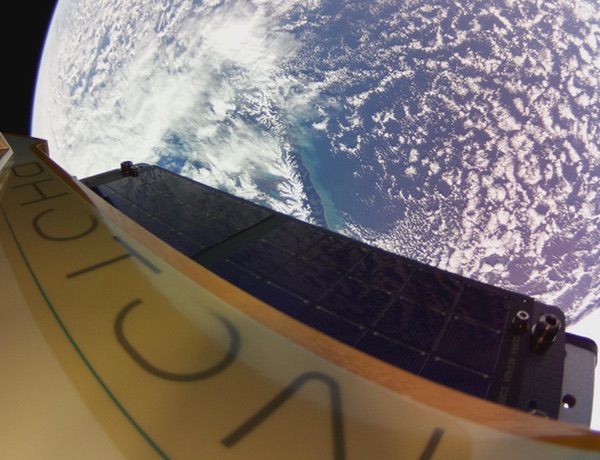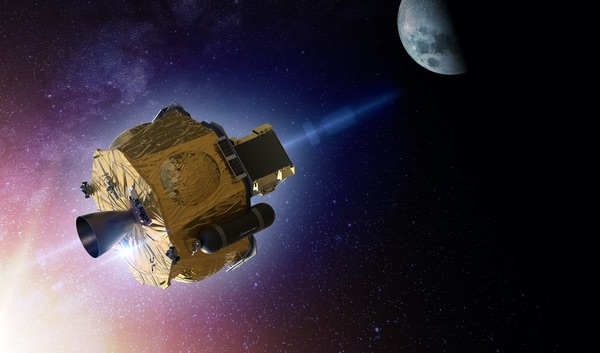Photons and phosphineby Jeff Foust
|
| “This is our very first Rocket Lab-built and designed satellite,” Beck said. “For the first time we are a complete end-to-end service.” |
Rocket Lab announced the Photon program in the spring of 2019. The company planned to turn the kick stage it developed for Electron into a satellite bus, offering it to customers who didn’t want to develop their own satellite bus and might prefer an integrated solution—rocket and satellite, as well as ground stations—rather than buying them from different companies.
“Our focus this year is really all about the spacecraft, because that’s really the next big thing that needs to be solved,” Beck said in February. “Most people know Rocket Lab as a launch company, but we’re very much focusing on being a space company.”
The Photon launched on this mission, dubbed “First Light,” brings the company closer to being known as more than a launch company. “This is our very first Rocket Lab-built and designed satellite,” Beck said in a September 3 call with reporters to announce the achievement. “For the first time we are a complete end-to-end service.”
First Light is a technology demonstration mission, testing subsystems, like power, thermal management, and attitude control, that had not previously flown on the kick stage Photon is adapted from, as well as a camera that has provided images of the satellite and the Earth. The satellite will remain in orbit for several years, and will be available for potential customers to test. “This mission is all about a working example for our customers to play with,” he said.
Beck, in that call, reiterated his belief that Photon is a solution for companies that want to get their payloads launched while minimizing time and effort. “It’s designed to be really configurable,” he said. “We designed something that is best-in-class that covers a wide variety of missions.” Because Photon doubles as the kick stage of the Electron, he noted that the rocket’s entire capacity—recently increased from 150 to 200 kilograms for Sun-synchronous orbits—can be used for useful payloads.
Interest in Photon ranges from emerging satellite businesses that want to get payloads into orbit faster to the US government, which Beck said is interested because of the “incredibly high delta-V,” or change in velocity, that Photon offers, allowing it to change orbits. However, the company has yet to identify any of those potential customers.
The exception to that is NASA, which awarded Rocket Lab a contract in February for its Cislunar Autonomous Positioning System Technology Operations and Navigation Experiment (CAPSTONE) satellite. CAPSTONE will go to the Moon to test out the stability of the near-rectilinear halo orbit that NASA will use for the lunar Gateway. CAPSTONE will launch on an Electron, with a Photon sending CAPSTONE to the Moon. Once at the Moon, CAPSTONE will use its propulsion system to enter the halo orbit.
 An image taken by Rocket Lab’s “First Light” Photon spacecraft after its launch last month. (credit: NASA) |
“It would be rude not to”
There may be a second potential customer for Photon. In recent months, Beck has talked about using Photon to send a mission to Venus. That mission, privately funded, would look any life that some scientists have proposed might exist in the planet’s upper atmosphere, where conditions are far more hospitable than its surface.
“I love Venus,” he said in a company webcast in early August, citing that potential for life in its atmosphere. “I’m working very hard to put together a private mission to go to Venus in 2023.”
| “It’s a real turning point in space if private missions can occur.” |
The concept, he said in the Photon press conference, would involve a spacecraft deploying a probe that would enter the atmosphere as it flies by the planet. A small mission like that could provide a “tremendous amount of scientific data” about the planet’s atmosphere, including any evidence of life there.
The mission would be done outside the framework of NASA or any other space agency, he said. “It puts a flag in the ground. A private mission to another planet sets a trajectory for where we need to go,” he said. “It’s a real turning point in space if private missions can occur.”
Beck hasn’t disclosed how much such a mission would cost, and if the company would leverage other non-government funding sources to pay for it. “I’m spending as much time as I can on it,” he said in an interview last month. “We are very serious about this mission.” That includes assembling what he called “an amazing science team” to support it.
Those comments all came before the announcement September 14 that scientists using groundbased telescopes had detected traces of phosphine in the atmosphere of Venus. The only known explanation for the quantities of phosphine seen there, scientists involved in the discovery said, is that there is life, like anaerobic microbes found on Earth, creating it (see “Why the detection of phosphine in the clouds of Venus is a big deal”, The Space Review, September 21, 2020).
Among those involved in the phosphine discovery is Sara Seager, an MIT professor. In a Royal Astronomical Society press conference about the detection of phosphine, she said she had been in discussions with Beck about what a Photon mission to Venus could do. One challenge, she acknowledged, is the small size of the spacecraft: its mass would only be about 15 kilograms, of which 3 kilograms would be available for a science payload.
“We have to work hard to make sure an instrument that would be useful for the search for life will fit into that payload,” she said. “We’re really looking forward to it.”
One such instrument would be a mass spectrometer, she said, capable of detecting not just phosphine but other, more complex, molecules that could provide more definitive evidence of life in the atmosphere of Venus. There may other options as well, she added. “We have a long list of things we’d like.”
If Rocket Lab can keep its Venus mission on schedule for launch in 2023, it could beat out other, albeit larger, missions under consideration by national space agencies. Two of four finalists in the latest round of NASA’s Discovery program of planetary science missions would go to Venus, including DAVINCI+, which would deploy an atmospheric probe. NASA plans to select up to two missions—the other two finalists being missions to Jupiter’s moon Io and Neptune’s moon Triton—next year, but would not launch until at least the middle of the decade.
| “We have to work hard to make sure an instrument that would be useful for the search for life will fit into that payload,” Seager said. |
ESA is considering a Venus mission called EnVision as part of its ongoing competition for a medium-class science mission in its Cosmic Vision program (see “EnVision and the Cosmic Vision decision”, The Space Review, March 2, 2020). Russia has been working on a Venus mission concept called Venera-D for several years, but would not launch until late this decade. India is working on a Venus orbiter mission concept called Shukrayaan-1, but that is unlikely to launch before 2023.
A smallsat mission to Venus would not replace larger missions like those contemplated by NASA and other space agencies, but could help refine their development. NASA has started to support other smallsat planetary science missions through its Small Innovative Missions for Planetary Exploration (SIMPLEx) program. In 2019, it selected three smallsat missions for study and eventual development as part of SIMPLEx: Escape and Plasma Acceleration and Dynamics Explorers (EscaPADE) to study the Martian atmosphere, Janus to visit binary asteroids, and Lunar Trailblazer to map water ice deposits on the Moon.
SIMPLEx has supported continued work on all three missions, but not without hiccups. Earlier this month, NASA officials said that EscaPADE had been bumped from its original launch, as a secondary payload on the launch of the Psyche mission, after determining that design changes needed to the smallsat mission to accommodate a different trajectory for Psyche could not be done on the schedule for the Psyche mission. Janus will still fly as a secondary payload on the Psyche launch, while Lunar Trailblazer will be a secondary payload on another NASA mission launching in 2024.
The Rocket Lab approach, by contrast, is more streamlined, self-contained approach, with control over the launch that a smallsat secondary payload doesn’t have. A successful Venus mission might demonstrate a new approach for smallsat planetary science missions that could get around the hassles of finding, and sometimes losing, a rideshare launch opportunity.
Beck also made clear, long before the detection of phosphine at Venus, that exploration of the planet was worthwhile as a counterbalance to the far greater interest in going to Mars. “Mars is super interesting, and Mars has gotten a lot of attention because Mars is a planet where we will put a human footprint,” he said in the early August webinar. “But, Venus is the closest analog to Earth. Venus is Earth in a climate change disaster.”
“I just think it would be rude, if you have the capabilities and the desire, to not have a crack” at studying Venus and looking for life there, he concluded. “It would be rude not to.”
Note: we are temporarily moderating all comments submitted to deal with a surge in spam.
